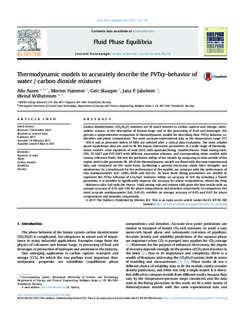| dc.contributor.author | Aasen, Ailo | |
| dc.contributor.author | Hammer, Morten | |
| dc.contributor.author | Skaugen, Geir | |
| dc.contributor.author | Jakobsen, Jana Poplsteinova | |
| dc.contributor.author | Wilhelmsen, Øivind | |
| dc.date.accessioned | 2018-03-06T14:03:02Z | |
| dc.date.available | 2018-03-06T14:03:02Z | |
| dc.date.created | 2017-02-13T08:48:16Z | |
| dc.date.issued | 2017 | |
| dc.identifier.citation | Fluid Phase Equilibria. 2017, 442 125-139. | nb_NO |
| dc.identifier.issn | 0378-3812 | |
| dc.identifier.uri | http://hdl.handle.net/11250/2488952 | |
| dc.description.abstract | Carbon dioxide/water (CO2/H2O) mixtures are of much interest in carbon capture and storage, atmospheric science, in the description of human lungs and in the processing of food and beverages. We present a comprehensive comparison of thermodynamic models for describing their PVTxyPVTxy behavior, i.e. densities and phase compositions. The most accurate experimental data in the temperature range 273–478 K and at pressures below View the MathML source61MPa are selected after a critical data evaluation. The most reliable phase equilibrium data are used to fit the binary interaction parameters of a wide range of thermodynamic models: cubic equations of state (EoS) with quadratic/Wong–Sandler/Huron–Vidal mixing rules, CPA, PC-SAFT and PCP-SAFT with different association schemes, and corresponding states models with various reference fluids. We test the predictive ability of the models by comparing to data outside of the region used in the parameter-fit. All of the thermodynamic models are fitted with the same experimental data and compared on the same basis, facilitating a general discussion about their strengths and weaknesses. As a benchmark for the performance of the models, we compare with the performance of two multiparameter EoS: GERG-2008 and EoS-CG. At least three fitting parameters are needed to represent the PVTxyPVTxy behavior of CO2/H2O mixtures within an accuracy of 10%. By including a fourth parameter, it is possible to significantly improve the accuracy for phase compositions, where the Peng–Robinson cubic EoS with the Huron–Vidal mixing rule and volume shift gives the best results with an average accuracy of 4.5% and 2.8% for phase compositions and densities respectively. In comparison, the most accurate multiparameter EoS, EoS-CG, exhibits an average accuracy of 8.0% and 0.6% for phase compositions and densities respectively. | nb_NO |
| dc.language.iso | eng | nb_NO |
| dc.publisher | Elsevier | nb_NO |
| dc.rights | Attribution-NonCommercial-NoDerivatives 4.0 Internasjonal | * |
| dc.rights.uri | http://creativecommons.org/licenses/by-nc-nd/4.0/deed.no | * |
| dc.title | Thermodynamic models to accurately describe the PVTxy-behavior of water / carbon dioxide mixtures | nb_NO |
| dc.type | Journal article | nb_NO |
| dc.type | Peer reviewed | nb_NO |
| dc.description.version | publishedVersion | nb_NO |
| dc.source.pagenumber | 125-139 | nb_NO |
| dc.source.volume | 442 | nb_NO |
| dc.source.journal | Fluid Phase Equilibria | nb_NO |
| dc.identifier.doi | 10.1016/j.fluid.2017.02.006 | |
| dc.identifier.cristin | 1449775 | |
| dc.description.localcode | © 2017 The Authors. Published by Elsevier B.V. This is an open access article under the CC BY-NC-ND license (http://creativecommons.org/licenses/by-nc-nd/4.0/) | nb_NO |
| cristin.unitcode | 194,64,25,0 | |
| cristin.unitname | Institutt for energi- og prosessteknikk | |
| cristin.ispublished | true | |
| cristin.fulltext | original | |
| cristin.qualitycode | 2 | |

